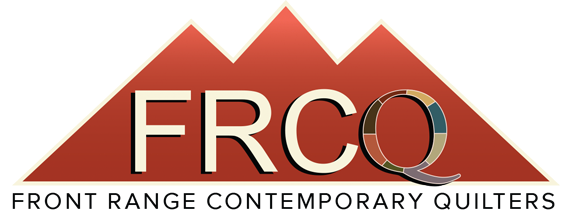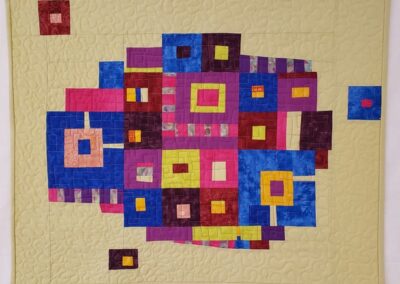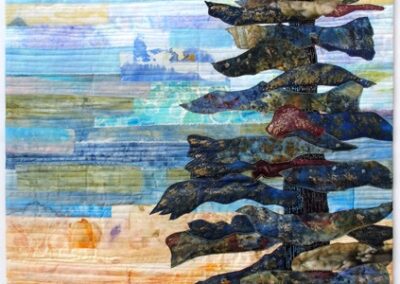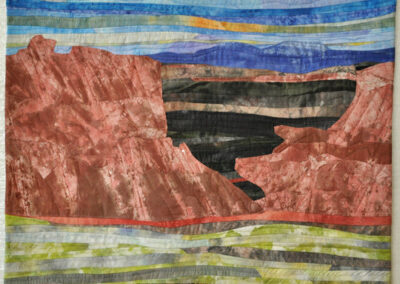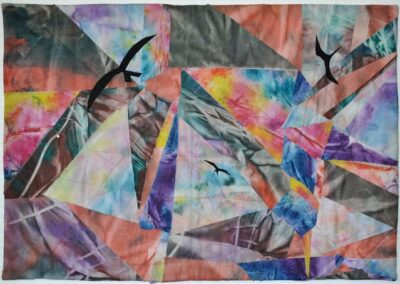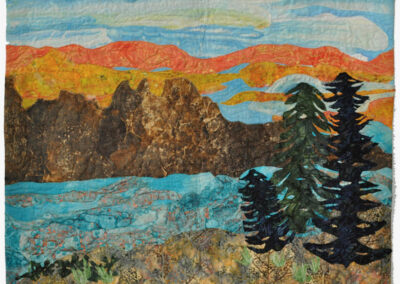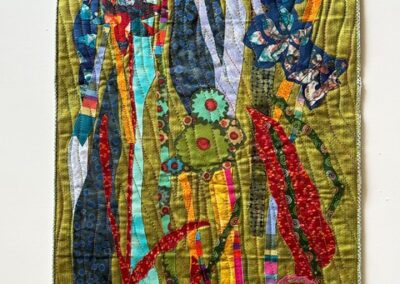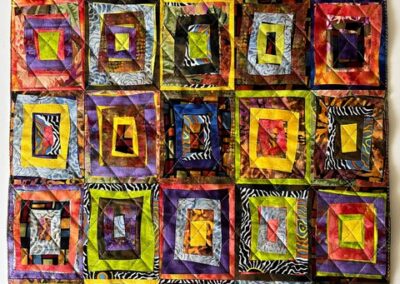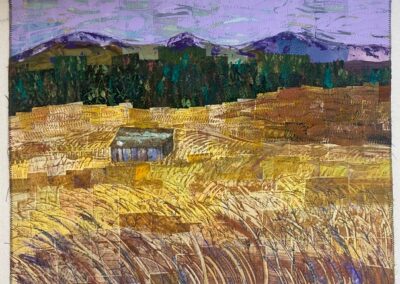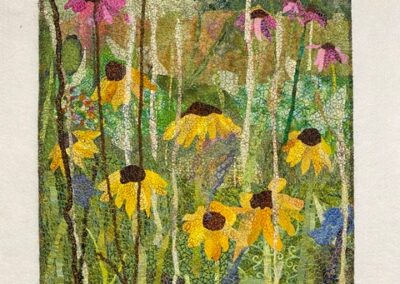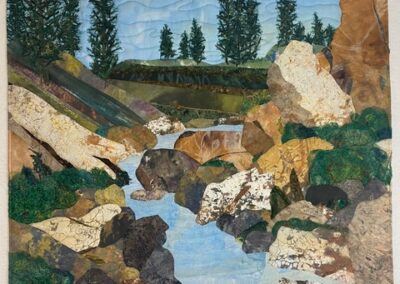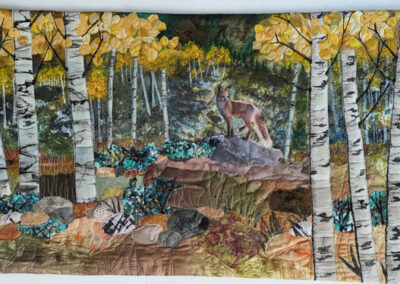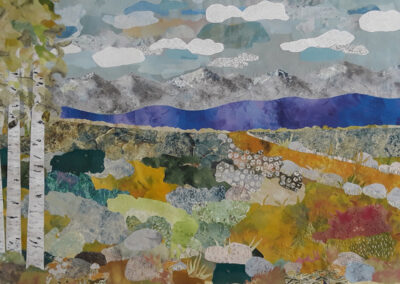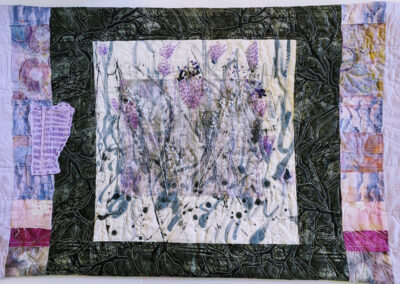A CLASS ACT
Online Challenge
Curator’s Comments by Ruth Murayama
It has been a pleasure reviewing all of the submittals for A Class Act Challenge. This unjuried show was a chance for artists to share their works originally started in a class and influenced by a teacher’s instructions. Or in some cases, it shows how an artist may be initially influenced by a teacher’s style and then breaks away in their own voice. This collection of landscapes, abstraction and modern shapes is a diverse, visual treat.
My favorite piece was Not in the Tall Grass because of its painterly features and use of color. I liked how the fabric painting added rich textures to the landscape.
Enjoy this online showcase of our members’ work!
“Class Act”
(Click on an image to enlarge)
INSPIRED BY ERTE, Kathleen Mead
This piece was begun in David Owen Hastings’s “Inspired by Art” online workshop in January of this year. I selected a print of one of Erte’s theatrical costume designs for the colors and the beautiful drape of the fabrics in the print. Initially, as per the workshop instructions, I created four fairly large blocks based on small sections of the print. When placed on my design wall, they felt too large. I cut them into quarters, rearranged the pieces, and added the top & bottom borders.
Methods/Materials: Improv pieced cotton fabrics, batting, and threads; improv quilting. The quilting is inspired by the flowing lines of the costume in the original print.
TOWN & COUNTRY, Kathleen Mead
This quilt was begun in a Cindy Grisdela Zoom workshop on improv piecing in March of 2021. The striped sections were actually trimmings from another small quilt. Although they weren’t part of the workshop plan, I decided to use them in this improv log cabin design. I challenged myself to work with fabrics that I had in my scrap bin or stash and had fun “letting loose!”
Methods/Materials: Improv pieced quilting cottons; cotton batting; cotton/poly threads. Since I was still new to improv/free-motion quilting, I stared at the piece for a while until deciding on a quilting plan — an interlocking square design in variegated thread for the “town” and a loose stippling to mimic treetops for the “country.”
SENTINEL OF THE SOUND, Anne Severn
Sentinel of the Sound was inspired by a majestic lone tree on the wild shoreline of the property my great grandfather owned on Puget Sound. During the first half of the 20th century “The Sentinel” was an important landmark to the mariners plowing their way through the waters of Puget Sound.
Methods/Materials: Acrylic paint on cotton, raw edge applique, stitching. Cotton fabric, acrylic paint, felt batting, cotton thread.
TWIN PEAKS, Susan Serreze
I was inspired to create this piece from the hand painted water and sky fabrics that I had previously made. I added mountains, trees, and a foreground that was inspired by photos of Colorado. I enjoy the outdoors and take many photos while outside. This piece was made in a Jean Herman class.
Methods/Materials: Commercial and hand painted and dyed fabrics. Fused and stitched. Machine quilted.
STORM, Susan Serreze
The only fabric I brought to a Patty Hawkins class was a set of hand painted fabrics created in a Denise Labadie class. The design came together gradually, coordinating the colors and the triangle shapes. Once done, it felt like a storm. The birds were appliqued on to help give context to the storm.
Methods/Materials: Hand painted fabrics fused and stitched. Applique. Storm was created using improvisional piecing of triangular shapes. The triangles were created using building structure as a guide.
BEAR’S EARS, Susan Serreze
The Bears Ears National Monument has been surrounded by controversy for decades. This piece tries to capture the spirit of Bears Ears National Monument, especially, the rock formations. I created this piece in a Denise Labadie class. It was fun to create the fabric to use in this piece.
Methods/Materials: Hand painted fabric, commercial cotton, hand applique, and strip piecing.
WINDOWS, Ruth Murayama
This piece is one of four composition techniques from a class with Sue Banner. The rectilinear composition consists of wonky cut rectangles and explores color combinations.
Methods/Materials: Raw edged appliqué using fusible web and commercial cottons. Machine quilting.
MANIC MEADOW, Ruth Murayama
This piece was made in Sue Benner’s Driven to Abstraction class in 2015. Bright colors and abstract flora thrive in this wild meadow.
Methods/Materials: Raw edged applique using fusible web and commercial cottons. Machine quilting.
BLOOM, Cynthia Jarest
Echinacea flourishes in the dry sunny climate of Colorado. The purple and yellow flowers grace yards, and fields, and pots, brining color everywhere.
Methods/Materials: Commercial and hand-dyed fabric, velvet, batting, fusible web, yarn and variegated thread. Flowers and stems are created by loosely cutting fabric, fused, then crazy stitched.
NOT IN THE TALL GRASS, Cynthia Jarest
Fields of blowing grasses can hide secret life; from birds, to mice, to rabbits, and many insects.
Methods/Materials: Commercial and hand-dyed fabric, stamps, acrylic paint, vinyl, and variegated thread. Fabric is painted with multiple tools and techniques, then the overall composition is monoprinted using vinyl and acrylic paint to create texture and movement.
SPRING RUNOFF, Cynthia Jarest
After the long snowy winter months, and the temperature warms, the snow begins to melt. Spring runoff is the bringer of life, rivers run high, lakes fill, and waterfalls roar.
Methods/Materials: Materials include commercial and hand-dyed fabric, silk, yarns, tulle, fusible web, water soluble material and variegated thread. Fabric has been dyed, then treated with flour or glue, cracked, then dyed or paint goes over the top to create fabric the has cracks and/or veins throughout. Trees are created individually with tiny cut fabric, secured and stitched down with tulle.
THE SENTINEL, Sue Lewis
My textile work is largely inspired by words that resonate with me, surface designed fabric and the beauty of nature. My art pieces incorporate hand-stitching and I use a wide variety of textiles, including vintage kimono silk, upholstery, hand-dyed or painted fabric, wool, Tyvek, dryer sheets and organza. I often include found objects, wire, feathers, paper, mica, twigs and clay. My intention is to connect with the viewer and draw them in for a closer look by presenting unusual imagery or materials. Repurposing is a strong pathway enabling me to connect the past with the present and adding imperfection to my aesthetic.
Methods/Materials: In celebration of colors and movement, I layered and fused a variety of fabrics. The quilt was made after taking a class with Marianne Williamson. She emphasized adding a wide variety of fabrics, including hand-dyed cotton, silk, and velvet and leaving raw edges for texture and movement. I used a photo taken by Brandee Green and printed it on organza. It was then machine quilted.
SPRING MEADOW, Sue Lewis
Same statement.
Methods/Materials: In celebration of colors and movement, I layered and fused a variety of fabrics. The quilt was made after taking a class with Marianne Williamson. She emphasized adding a wide variety of fabrics, including hand-dyed cotton, silk, and velvet and leaving raw edges for texture and movement. I used a photo taken by Brandee Green and printed it on organza. It was then machine quilted.
DARK SHADOWS, Sue Lewis
Same statement.
Methods/Materials: Dark Shadows was inspired by nature in all it’s imperfections. This piece includes hand-painted fabrics, including organza, linen and commercial fabric with hand and machine stitching. The course was titled “Perfectly Imperfect” taught by Lorna Crane, through Fibre Arts Take Two.
